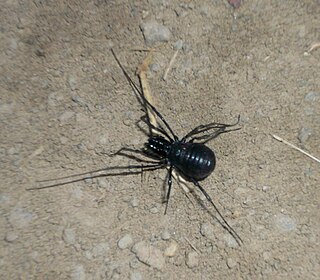
Xysticus is a genus of ground crab spiders described by C. L. Koch in 1835, belonging to the order Araneae, family Thomisidae. The genus name is derived from the Ancient Greek root xyst, meaning "scraped, scraper".

Opilio is a genus of harvestmen with 35 known species.

Dyspnoi is a suborder of harvestmen, currently comprising 43 extant genera and 356 extant species, although more species are expected to be described in the future. The eight families are currently grouped into three superfamilies: the Acropsopilionoidea, Ischyropsalidioidea, and Troguloidea.

The Phalangiidae are a family of harvestmen with about 380 known species. The best known is Phalangium opilio. Dicranopalpus ramosus is an invasive species in Europe.

The Sironidae are a family of harvestmen with more than 60 described species.

Trogulidae is a family of harvestmen comprising 65 extant species in five genera.

Ischyropsalididae is a family of harvestmen with 35 described species in 3 genera, found in Europe and North America.

The Ceratolasmatidae are a family of harvestmen with eleven described species.

Zelotes is a genus of ground spiders that was first described by J. Gistel in 1848.

Centromerus is a genus of dwarf spiders that was first described by David B. Hirst in 1886.

Bassaniodes is a genus of crab spiders that was first described by Reginald Innes Pocock in 1903.
Crosbycus is a potentially monotypic genus of harvestmen in the family Taracidae, with one species found in North America as of 2023, per the World Catalog of Opiliones.

Ischyropsalis is a genus of harvestmen in the monotypic family Ischyropsalididae, with 24 described species.. They are found in Europe.
Giljarovia is a genus of harvestmen in the family Nemastomatidae with 11 described species from the Caucasus region.

Nemastomatinae is a subfamily of harvestmen with over 125 described species in 19 (extant) genera. They are usually found in temperate regions.











